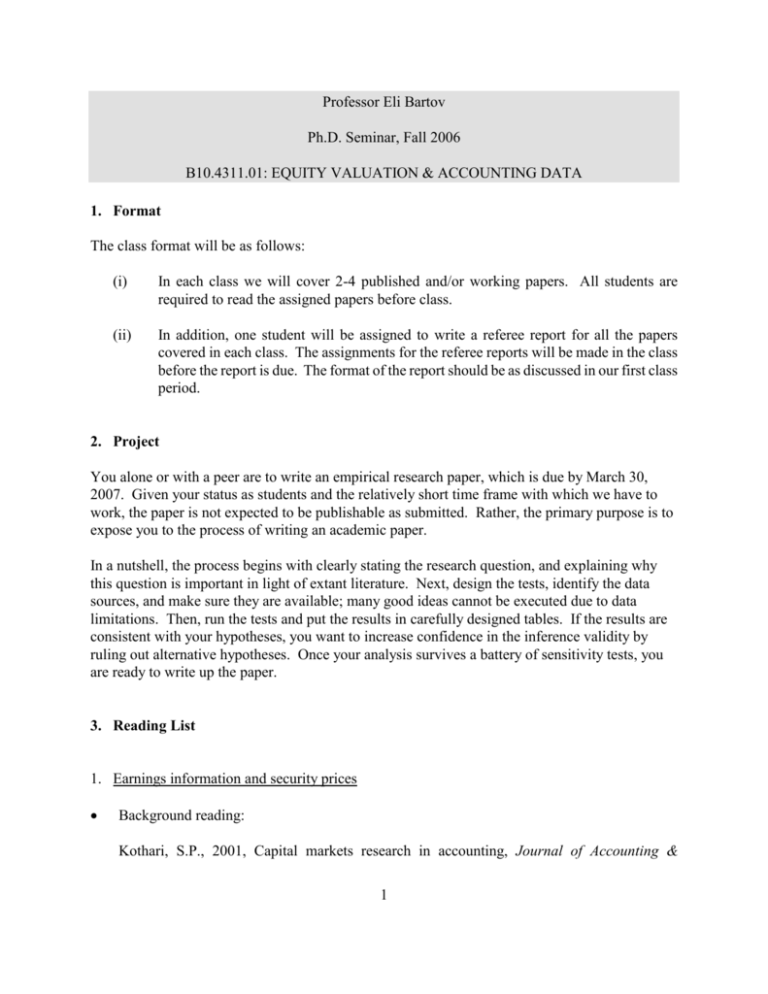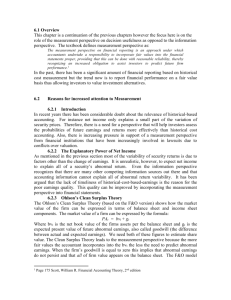B10.4311.01 - New York University
advertisement

Professor Eli Bartov Ph.D. Seminar, Fall 2006 B10.4311.01: EQUITY VALUATION & ACCOUNTING DATA 1. Format The class format will be as follows: (i) In each class we will cover 2-4 published and/or working papers. All students are required to read the assigned papers before class. (ii) In addition, one student will be assigned to write a referee report for all the papers covered in each class. The assignments for the referee reports will be made in the class before the report is due. The format of the report should be as discussed in our first class period. 2. Project You alone or with a peer are to write an empirical research paper, which is due by March 30, 2007. Given your status as students and the relatively short time frame with which we have to work, the paper is not expected to be publishable as submitted. Rather, the primary purpose is to expose you to the process of writing an academic paper. In a nutshell, the process begins with clearly stating the research question, and explaining why this question is important in light of extant literature. Next, design the tests, identify the data sources, and make sure they are available; many good ideas cannot be executed due to data limitations. Then, run the tests and put the results in carefully designed tables. If the results are consistent with your hypotheses, you want to increase confidence in the inference validity by ruling out alternative hypotheses. Once your analysis survives a battery of sensitivity tests, you are ready to write up the paper. 3. Reading List 1. Earnings information and security prices Background reading: Kothari, S.P., 2001, Capital markets research in accounting, Journal of Accounting & 1 Economics 31, 105-231. Read sections 1-3 and section 4.1.1. 1.1. Early studies Ball, Ray, and Philip Brown. 1968. An empirical evaluation of accounting income numbers, Journal of Accounting Research, 159-178. Beaver, William H. 1968. The information content of annual earnings announcements, Journal of Accounting Research, Supplement, 67-92. 1.2. Methodological issues Beaver, W., R. Clarke, and W. Wright. The Association Between Unsystematic Security Returns and the Magnitude of Earnings Forecast Errors. Journal of Accounting Research (Autumn 1979) 316–340. Easton, Peter D., Trevor S. Harris, and James A. Ohlson. 1989. Accounting earnings can explain most of security returns: The case of long event windows, Journal of Accounting & Economics 15, 119-142. Freeman, Robert N., and Senyo Tse. 1992. A nonlinear model of security price responses to unexpected earnings, Journal of Accounting Research 30, 185-209. Cheng, C.S. Agnes, William S. Hopwood, and James C. McKeown. 1992. Nonlinearity and specification problems in unexpected earnings response regression model, The Accounting Review 67, 579-598. 1.3. Determinants of earnings response coefficients (ERCs) Easton, Peter, D., and Mark E. Zmijewski. 1989. Cross-Sectional Variations in the Stock Market Response to Accounting Earnings Pronouncements. Journal of Accounting and Economics, Vol. 11, pp. 117-141. Collins, D., S.P. Kothari, J. Shanken, and R. Sloan. 1994. Lack of Timeliness and Noise as Explanations for the Low Contemporaneous Returns-Earnings Association. Journal of Accounting and Economics 18, 289-324. Hayn, C. 1995. The Information Content of Losses. Journal of Accounting and Economics, 125-153. 2 2. Intraday analysis of return data Lee, C., B. Mucklow, and M. Ready. 1994. Spreads Depths and the Impact of Earnings Information: An Intraday Analysis. The Review of Financial Studies 6, 345-374. Patell, J., and M. Wolfson. 1984. The Intraday Speed of Adjustment of Stock Prices to Earnings and Dividend Announcements. Journal of Financial Economics (June), 223– 252. 3. Management of accounting appearances 3.1. Earnings management Background reading: Schipper, K. 1989. Commentary on earnings management, Accounting Horizons 3, 91-102. 3.1.1. Accrual-based earnings management Methodological issues: Bartov, E., F.A. Gul, and J.S.L. Tsui. 2000. Discretionary accruals models and audit qualifications, Journal of Accounting and Economics 30, 421 – 452. Existence: DeFond, M.L., and J. Jiambalvo. 1994. Debt covenant violation and manipulation of accruals.” Journal of Accounting and Economics 17, 145-176. 3.1.2. Transaction-based (real) earnings management Bartov, E. 1993. The timing of asset sales and earnings manipulations, The Accounting Review 68, 840 - 855. 3.2. Earnings management and earnings expectations management to exceed thresholds Degeorge, F., J. Patel and R. Zeckhauser. 1999. Earnings management to exceed thresholds, Journal of Business, 72 (1): 1-33. 3 Bartov, E., D. Givoly, and C. Hayn. 2002. The rewards for meeting-or-beating earnings expectations, Journal of Accounting and Economics 33, 173 – 204. 3.3. Earnings management pre- and post-Sarbanes Oxley Act. Bartov, E., and D. Cohn. 2006. Mechanisms to Meet/Beat Analyst Earnings Expectations in the Pre- and Post-Sarbanes-Oxley Eras. 4. Employee stock option Background reading: Murphy, K.J. 1999. Executive compensation, in: O. Ashenfelter and D. Card, eds., Handbook of Labor Economics Volume 3B (North Holland, Amsterdam). Bebchuk, L.A., J.M. Fried, and D.I. Walker. 2002. Managerial power and rent extraction in the design of executive compensation. The University of Chicago Law Review 69, 751-846. 4.1. Executive stock options and incentive alignment Rajgopal, S., and T. Shevlin. 2002. Empirical evidence on the relation between stock option compensation and risk taking. Journal of Accounting and Economics 33, 145-171. Mehran, H. 1995. Executive compensation structure, ownership, and firm performance, Journal of Financial Economics 38, 163-184. 4.2. Executive stock options and managerial opportunistic behavior 4.2.1 Estimating executive stock option cost Bartov, E., P. Mohanram, and D. Nissim. 2004. Managerial Discretion and the Economic Determinants of the Volatility Parameter for Valuing ESOs. Working paper, NYU and Columbia University. 4.2.2 Option grants backdating Yermack, D. 1997. Good timing: CEO stock option awards and company news 4 announcements. The Journal of Finance 52, 449-476. Lie, E. 2005. On the timing of CEO stock option awards, Management Science 51, May 2005, pp. 802-812. Heron, R.A., and E. Lie. 2006. Does backdating explain the stock price pattern around executive stock option grants?" Forthcoming, Journal of Financial Economics. 4.2.3 Private information and executive stock option exercises Huddart, S., and M. Lang. 2003. Information distribution within firms: Evidence from stock option exercises. Journal of Accounting and Economics 34, 3-41. Bartov, E., and P. Mohanram. 2004. Private information, earnings manipulations, and executive stock option exercise. The Accounting Review 79, 889-920. 5. International Accounting 5.1. Accounting earnings, an international comparison Ball, R., Kothari, S., Robin, A., 2000. The effect of international institutional factors on properties of accounting earnings. Journal of Accounting and Economics 29, 1-51. Fan, J., and T.J. Wong. 2002. Corporate ownership structure and the informativeness of accounting earnings in East Asia. Journal of Accounting and Economics 33:401-425. 5.2. Earnings management around the world Leuz, C., D. Nanda, P. Wysocki. 2003. Earnings management and investor protection: an international comparison. Journal of Financial Economics 69, 505-527. La Porta, R., F. Lopez-de-Silanes, and A. Shleifer. 2003. What works in securities laws? NBER Working Paper No. w9882 Issued in August 2003. Haw, I., B. Hu, L. Hwang, and W. Wu. 2003. Ultimate ownership, income management, and legal and extra-legal institutions. Journal of Accounting Research, forthcoming. Wysocki, P. 2003. Earnings management, tax compliance, and institutional factors: a discussion of Haw et al [2004], Journal of Accounting Research, forthcoming. 5 6. Corporate governance Bushman, R., and A. Smith. 2003. Transparency, financial accounting information, and corporate governance, Federal Reserve Bank of New York Economic Policy Review, 65-87. Gompers, P., J. Ishii, and A. Metrick. 2003. Corporate governance and equity prices, Quarterly Journal of Economics 115, 107-155. Klein, A., 2002, Audit committee, board of director characteristics, and earnings management, Journal of Accounting & Economics 33, 375-400. Robert Bowen, Shiva Rajgopal, and Mohan Venkatachalam. 2002. Accounting Choice, Corporate Governance, and Firm Performance. Working paper, Available on the SSRN. 7. The Ohlson Valuation Model Ohlson, J.A. 1995. Earnings, Book Values, and Dividends in Equity Valuation. Contemporary Accounting Research Vol. 11(2) (Spring 1995) 661-687. Feltham G.A. and J.A. Ohlson 1995, Valuation and Clean Surplus Accounting for Operating and Financial Activities, Contemporary Accounting Research, 11(Spring), 689-731. Feltham G.A. and J.A. Ohlson 1996, Uncertainty Resolution and Depreciation , Journal of Accounting Research, Vol. 34, No. 2, Autumn, 209-234. 8. The Ohlson Valuation Model, Continued Gode, D., and J. Ohlson. 2004. Accounting-Based Valuation with Changing Interest Rates. Working paper, NYU. Ohlson, J., and X. Zhang. 1998. Accrual Accounting and Equity Valuation. Journal of Accounting Research 36, Supplement 1998, 85-111. Ohlson, James A., 2001. Earnings, Book Values, and Dividends in Equity Valuation: An Empirical Perspective. Contemporary Accounting Research Vol. 18 No. 1, Spring 2001. 6 9. The Ohlson Valuation Model: Empirical Tests Dechow P., A. Hutton and R. Sloan. 1999. An Empirical Assessment of the Residual Income Valuation Model. Journal of Accounting and Economics 26, 1-34. Myers J. 1999. Implementing Residual Income Valuation with Linear Information Dynamics. The Accounting Review 74, 147-161. Liu J., and J.A. Ohlson. 2000. The Feltham-Ohlson (1995) Model: Empirical Implications. Journal of Accounting Auditing and Finance 15 (3), 321-331. 10. Market efficiency and accounting information 10.1. Post earnings announcement drift Bernard, V. L., and J. Thomas. 1990. Evidence that stock prices do not fully reflect the implications of current earnings for future earnings, Journal of Accounting and Economics 13, 305-340. Bartov, E. 1992. Patterns in unexpected earnings as an explanation for post-announcement drift, The Accounting Review 67, 610-622. Ball, R., and E. Bartov. 1996. How naive is the stock market’s use of earnings information? Journal of Accounting and Economics 21, 319-337. Bartov, E., S. Radhakrishnan, and I. Krinsky. 2000. Investor sophistication and patterns in stock returns after earnings announcements. The Accounting Review 75, 43 – 63. 10.2. Pricing of accruals and cash flows Sloan, R.G. 1996. Do stock prices reflect information in accruals and cash flows about future earnings?” The Accounting Review 71, 289-306 Collins, D.W., G. Gong, and P. Hribar. 2003. Investor sophistication and the mispricing of accruals. Review of Accounting Studies 8, 251-276. Bartov, E. 2003. Discussion of ‘investor sophistication and the mispricing of accruals.’ Review of Accounting Studies 8, 277 – 281. 7







